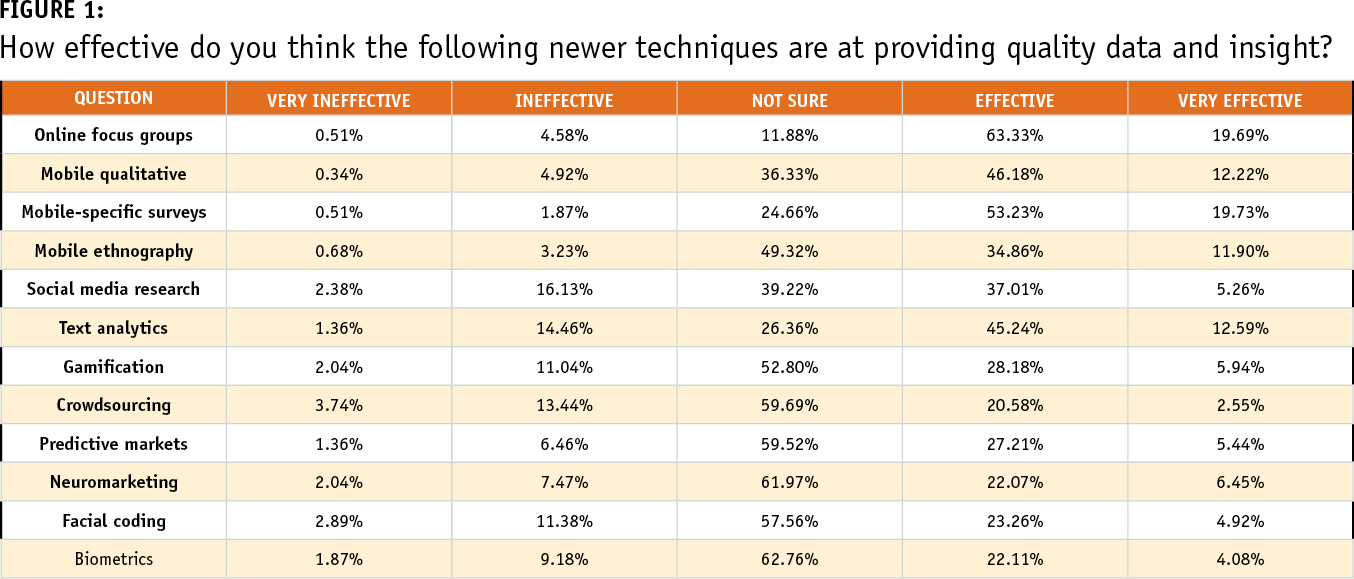Marketing research and insight professionals discuss methodologies and technologies in 2022
What tools are client-side marketing research and insights professionals turning to? What methodologies and technologies do they hope to utilize in the future? Do corporate researchers see newer techniques as useful, providing quality data and insight?
These are just a few of the questions our team asks each year. In fact, our annual Q Report, published Sept. 2022, asked client-side researchers, “How effective do you think the following newer techniques are at providing quality data and insight?” Online focus groups, mobile-specific surveys and mobile qual were the most likely to be rated as very effective or effective by respondents (Figure 1).

In addition, we asked respondents to characterize their organizations’ tendencies when it comes to adopting new methodologies. Less than 3% selected innovator and 45% selected among the late majority. You can read more about the Q Report findings in Quirk’s Editor Joe Rydholm’s article, “Ninth annual Q Report finds abiding faith in qualitative methods and growing worry about data quality threats, reestablishing relevance.”
To get a more in-depth look at the trends, methodologies and tools that client-side researchers are turning to in their day-to-day work, we decided to review responses found in our Q&A series with corporate researchers. In the last 12 months, we’ve asked several client-siders what tools, methodologies and techniques they are turning to and why. We hope that the following responses will give you a bit of an inside look at how marketing research and insight departments are evolving.
Layering multiple data sources
“A recent focus for our team has been layering multiple data sources onto primary quantitative research to paint a more holistic picture of results. While the list of potential resources is endless, the most impactful technique I’ve recently brought on board is AI trend analysis. We’re still getting our feet wet, but have found success with Tastewise, a tool that aggregates social media data with food service and menu insights to identify flavor trends, ingredients and consumer benefits.
“For the many researchers who frequent TURF analysis, we typically see results that show relatively strict preference for one to two flavors, but several flavor options for sets of three and beyond when reach begins to taper off. While it’s always great to report back to stakeholders that there is flexibility to prioritize internally loved flavors, we’ve found supplementing the research with social insights adds a rich layer to flavor prioritization. Tastewise provides information on the maturity of a flavor within its category lifecycle, as well as social growth rates, flavor trend projection and ingredient usage in recipes and on menus. By tapping into this data, we’re able to give stakeholders a fuller picture on the implications of launching a given flavor, which positions us with a greater chance of success.” Jessica Noteware, Chobani
Focusing on agile
“I do see an opportunity to continue to utilize more and more remote tools, as a way of making it easier to connect with underserved communities and lowering the barrier to insights. Within financial tech, we are also always balancing between agility and rigor, so we get to adopt methods to make them lighter weight/hybrid as a way of achieving insights faster to meet business objectives.” Jeta Surman, American Express
“There are many new solutions that offer quick, turn-key product research. Given the internal need for faster insights we are always evaluating these solutions with a close eye on research quality to ensure that we’re compromising where we can but not making any sacrifices to our data quality.” Ali Beck, Ferrara
Psychographics
“One focus area we have is to dig deeper into how we think about our consumers and the way we identify and talk about cohorts and platform segmentations. We’re still a pretty young company in the scheme of things and traditional segmentation work costs hundreds of thousands of dollars and a lot of time to execute. Now that we’re playing in spaces beyond yogurt, we also need to think about how these segments carry over to different categories and interact with one another. Is someone who prioritizes flavor and the taste experience over, say, nutritional composition in yogurt [going to do] the same in coffee creamers? How similar or unique is the consumer that is buying our oat milk from the consumer buying our cold brew made with oat milk?
“Our approach to psychographics is something we’re starting to put a real critical lens on – especially at the quantifiable level. A challenge really resides in the art and science that is needed. We need any frameworks or tools we lean on to truly be grounded in data, but we also need them to speak to the true nuances and nature of consumers – we know how complex people are, as well as say how many different segments can exist in a given cohort or category. We’re looking for ways to codify their values and behaviors in a way that helps paint a simple, easy to understand picture, yet gives us the depth to be able speak to them in a way that truly resonates. Providing more value to them and creating a deeper human connection is imperative to the perception and health of the Chobani brand.” Elizabeth Pfeiffer, Chobani
Tools that fit the need
“Consumer insights should be focused on finding unmet needs, guiding strategy and building consumer empathy. When I think about next year I’m less interested in the shiny new tool and more interested in how I can scale our current tools to fit the needs of my business. …
“I’d like to get the Traeger team away from their computers a little more and get them in people’s backyards, listening into customer service calls, being in retail and generally having those moments of discovery that are vital to an innovative company like Traeger.” Jason Alleger, Traeger Grills
If you’d like to learn more about the state of the industry from the client side, watch for new Q&As in each issue of Quirk’s magazine and e-newsletter.
